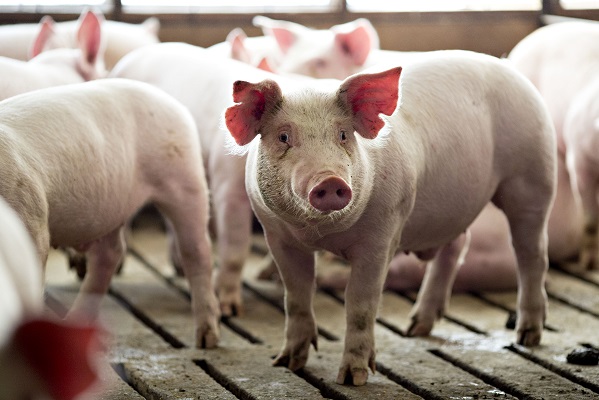

Lowering antibiotic usage is easier said than done, as it usually coincides with a drop in farm margins. It takes discipine and consistence. Greater emphasis is also being placed on correct diagnostics to ensure the right antibiotics are used at the right dosage to treat specific diseases.
The dosing procedure is also kept as short as possible, which is why antibiotics are increasingly delivered in water rather than feed. This is easier and simpler, and sick pigs tend to drink water rather than eat, especially after weaning.
Biosecurity and hygiene
A multidisciplinary approach involving improved genetics, animal husbandry and nutrition, as well as better health management, building engineering design and operation, is required to offset the negative spin-offs of lower antibiotic usage. However, hygiene and biosecurity are placed at the top of this list.
Biosecurity means keeping strangers and vehicles off the farm, providing shower facilities attached to the pig houses, and donning clothing and boots only for use in the pig houses. It also means an aggressive pest management programme to keep rats, mice, birds and other animals out of the production area. Biosecurity should be redoubled, as it’s your first line of defence against disease. Its ultimate goal is to prevent anything that might be carrying a harmful organism from getting near your animals
Equally important is controlling traffic of pigs onto the farm and into the pig houses, and incorporating new animals into a group only once their health history, source and status have been cleared.
Along with this comes cleanliness. Patience explains that many infections are dependent on the degree to which animals are exposed to the disease, and cleanliness minimises exposure.
Growing awareness of the importance of biosecurity and cleanliness has led to batch farrowing and all-in, all-out systems becoming increasingly popular.
Splitting the animals up into groups according to nutritional and management requirements eases production management. It also enables all the animals to be vaccinated on the same day.
To reduce the build-up of pathogens, rooms or buildings should be thoroughly sanitised once all the pigs have been moved out and before another group is moved in.
The water storage and delivery systems are sometimes neglected, these should be treated frequently to prevent pathogens from entering the production site, and to avoid the formation of biofilms in pipes and storage cisterns.
Stockmanship
This is generally defined as the ability to read an animal’s needs by paying attention to its behaviour, appearance and sounds, as well as the production environment and quality of food and water. Good stockmanship is non-negotiable
It ensures that pigs are well cared for, welfare is top notch, and production is efficient and profitable. No amount of diet formulation, feed additives, medications or expensive housing will overcome poor stockmanship.
For example, at feeding time, pigs don’t need an invitation to join the feast, but move en masse to get to the feed. Something is usually wrong when a pig does not participate and lies listlessly in a corner. Agitation, aggression, scratching, coughing, sneezing and laboured breathing are also signs of a problem.
It is not always possible to move all sick pigs to the sick pen, so if a single treatment results in recovery, the pig is normally left in the pen.
If illness persists, it should be moved to an isolated pen for treatment and care If the animal fails to respond to this, it should be euthanised to stop it suffering and prevent other pigs from becoming infected.
Health management
While health management is important throughout production, special attention should be given to newborn and newly weaned piglets. Animals neglected during these phases usually never catch up with well-cared-for animals.
This means ensuring they do not suffer from cold stress, each piglet receives enough good-quality colostrum within the first hours of life, and intervening when sows fail to produce enough milk.
To ensure piglets can stomach solids, the weaning age can be moved up to a week later. Where weaning at three weeks used to be seen as the best for overall sow productivity, many producers are switching to 23 to 25 days, with no loss in sow productivity and an improvement in weaned pig transition. The older weaning age is often driven by the desire to reduce antibiotics usage
 Contact Jaguza Support
Contact Jaguza Support